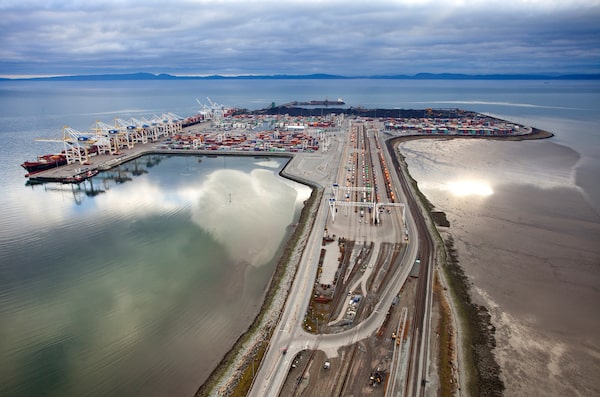
The port authority views the signed agreements as formal consent for RBT2.William Jans Photography/Vancouver Fraser Port Authority
The federal government has approved the Port of Vancouver’s proposed $3.5-billion container terminal, saying the project will spur economic growth while complying with environmental rules.
The government cleared the way for construction of the Roberts Bank Terminal 2 project, or RBT2, subject to 370 legally binding conditions.
At stake is the Canadian government’s mission to strengthen the country’s Asia-Pacific gateway strategy. Ottawa wants to ensure that Canada’s largest port is well positioned to handle increased transpacific trade, including shipments to and from China.
The Vancouver Fraser Port Authority, which began public consultations 12 years ago, emphasizes that it reached impact benefit agreements with 26 Indigenous groups. The port authority views the signed agreements as formal consent for RBT2.
“When we engage in good faith and let ourselves be guided by science, we can grow the economy in a way which advances reconciliation and protects the planet,” Natural Resources Minister Jonathan Wilkinson said during a news conference on Thursday.
Plans for RBT2 feature the creation of an artificial island to be located near Delta, B.C., about 30 kilometres south of Vancouver.
For years, the project has faced opposition from environmentalists, community activists and a rival proposal from one of the port’s own tenants, GCT Global Container Terminals Inc.
To avoid missing out on increased transpacific trade, the port authority argued that it needed to win regulatory and cabinet approval to build a new terminal that would be situated on reclaimed land. The port authority reports to the federal Transport Minister Omar Alghabra.
“The approval of this project was not taken lightly,” he said. “With strong measures, we will protect our ecosystem while increasing Canada’s supply chain capacity to ensure Canadians receive affordable goods on time.”
Mr. Alghabra is encouraging port executives and union leaders to resolves their differences over plans for semi-automation at RBT2.
Labour leaders have expressed concerns about the magnitude of automation. Rob Ashton, president of the International Longshore & Warehouse Union Canada, warned last month about “jobs being done by robots.”
One of the conditions of approval requires the port authority to provide a $150-million financial guarantee during the first three years of construction.
The port authority is touting RBT2 as crucial for anticipated growth in transpacific trade. It believes the three-berth terminal, to be completed by the early 2030s, would be necessary to alleviate shipping congestion on the West Coast, which in turn would help reduce bottlenecks in supply chains across the country.
But critics say there isn’t any shipping crisis looming on the West Coast for many years, factoring in capacity expansion at the Port of Prince Rupert in northern B.C.
GCT already runs a container site near Delta. GCT wants to increase container capacity at its three-berth Deltaport facility, proposing a fourth berth in a project called Deltaport 4.
The shipping industry deploys large vessels to carry containers, which are reusable steel boxes measured as 20-foot equivalent units, or TEUs.
Under its proposed expansion, GCT has forecast a total cost of up to $2-billion to add two million TEUs of annual container capacity at its facility by the early 2030s.
RBT2 would add 2.4 million TEUs a year.
Steven Guilbeault, Minister of Environment and Climate Change, said safeguards will be in place for the protection of endangered southern resident killer whales.
“The proponent must monitor noise levels to remain at or below a certain baseline level, implement procedures to delay departures of container vessels and reduce underwater noise during berthing activities when whales are present in the project area,” according to a news release issued by the Impact Assessment Agency of Canada.
The Georgia Strait Alliance, a marine conservation group, said the increased shipping traffic will have adverse environmental effects on the endangered whales.
Charlotte Dawe of the Wilderness Committee also criticized Ottawa’s green light for RBT2. “The Fraser estuary is an ecological jewel being sacrificed for corporate profits,” she said in an e-mail.
In statement late Thursday, port authority president Robin Silvester welcomed Ottawa’s decision.
“With this approval, we can advance one of Canada’s most important trade infrastructure projects to date, bolster our national supply-chain resilience, and deliver generational economic benefits for Canadians and Canadian businesses,” Mr. Silvester said.
He estimates that more than 18,000 jobs will be created during construction.